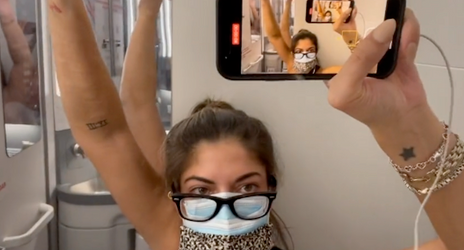Regardless of your present condition, a firm, shapely backside can be yours – provided you’re willing to put in the effort.
Without question, attaining a toned tush is a difficult endeavor. The gluteal region is a storehouse for body fat, containing an abundance of adipose cells. From a functional standpoint, lower body fat serves a dual purpose. First, it acts as an energy reserve in anticipation of pregnancy and lactation. Second, it helps cushion the posterior aspect of your pelvic bone (called the ischium) so you can sit down in relative comfort. Because of these factors, the body tends to hold on to fat in this area. While it‘s one of the first places for fat to accumulate, it’s generally the last to lose it (the first-in/last-out phenomenon).
To a certain extent, genetics will determine the size of your posterior. While some women are predisposed to a voluptuous physique with wide hips and lots of curves, others have more of an athletic build that’s characterized by a fairly even distribution of bodyweight. These genetic attributes are immutable; for better or for worse, you can’t change your basic physical structure. However, by target-training the glutes within your individual framework, there is virtually no limit to what can be accomplished. If your butt is flat, you can add shape and give it a rounded appearance. If your cheeks hang low, you can build them up to provide a natural lift. And if you have a little too much jiggle in your wiggle, you can enhance muscle tone to achieve a rock-hard look. Regardless of your present condition, a firm, shapely backside can be yours – provided you’re willing to put in the effort.
In order to get your rear in gear, it’s essential to establish a keen mind-to-muscle connection with the associated muscles during training. Since they are obscured from immediate view, most women are unable to effectively contract their glutes. In fact, many don’t even perceive that their derriere is actually made up of muscle! They’ll perform set after set of donkey kicks or pelvic lifts without really stimulating the area. Unfortunately, those who train in this fashion are doomed to failure. When performing any glute exercises, you must actively squeeze your butt on each rep, forcing it to contract. With consistent practice, you’ll notice a big difference in the quality of your workouts and you will literally leave your glute troubles behind.
Anatomy of the Glutes
The gluteal group consists of three separate muscles: the gluteus maximus, gluteus medius and gluteus minimus. The gluteus maximus is the largest of the gluteal muscles, accounting for the majority of muscular mass in the buttocks. Hence, the overall shape of your butt is largely determined by the development of this muscle. Its primary function is to extend the hip joint, allowing you to straighten your torso and bring your leg backward. The gluteus medius and gluteus minimus reside underneath and to the sides of the gluteus maximus. Their primary function is to bring the legs out and to the sides (a movement called abduction). Collectively, these muscles accentuate gluteal definition as well as firm up the hips.
Given the complexity of the gluteal muscles, it should be apparent that training them with one exercise simply isn’t enough; for optimal results, a multi-angled approach is required. To accomplish this task, the following types of movements should be incorporated into your workout:
Compound Thigh Movements. These exercises involve both the hip and knee joints and therefore target both the quadriceps and glutes (the glutes only have a function at the hip, not the knee). Accordingly, to maximize gluteal activity, you need to emphasize the amount of hip flexion in the move. For example, on the descent of the squat, your thighs should go below parallel with the ground and when performing leg presses, you should bring your thighs as close to your torso as possible. (A word of caution: Those with existing knee problems should generally refrain from this practice as it can exacerbate previous injury). Moreover, results can be heightened by performing these exercises unilaterally (i.e., one leg at a time), which forces many of the supporting muscles of the buttocks to contribute to performance.
Hip Extension Movements. These exercises involve straightening your hips from a flexed position, thereby targeting the glutes without significantly activating your thighs. You can accomplish this two ways: either by bending from your torso (as in stiff-legged deadlifts and good mornings) or by bending from your legs (as in the butt blaster). Doing so not only adds shape to your posterior by developing the gluteus maximus, but also activates the glute/ham stabilizer muscles, as well.
Abduction Movements. These exercises involve bringing the leg across the midline of the body, thereby targeting the gluteus medius and gluteus minimus (which are often overpowered by the much larger gluteus maximus). You can achieve additional posterior development by turning your legs out (lateral rotation) during abduction. This activates a group of muscles called the external rotators (including the piriformis, quadratus femoris, and several other muscles). Although small in size, these muscles are important both from a functional, as well as an aesthetic, perspective.
Glute Training Strategies
To avoid significant overlap between movements, I recommend performing one exercise from each group per session. As such, it’s generally best in this context to train your glutes and quads together in your routine. Make sure to perform different exercises from one workout to the next. Variety is the spice of training and by constantly varying your movements, you’ll ensure optimal stimulation of all available muscle fibers in the region.
As for the number of repetitions, it’s important to choose a range that’s consistent with to your goals. If you are looking to maximize the amount of the muscle in your glutes, then a moderate rep range of about eight to 10 reps per set is recommended. On the other hand, for those who just want to harden up without significantly bulking up, it’s advisable to employ a higher rep range of approximately 15 to 20 reps per set. Either way, make sure to train in an all-out fashion. The last few reps should be difficult, if not impossible, to complete. Any less from an effort standpoint and you’ll compromise results.
Provided you train with proper intensity, you should only need to work your glutes once per week. Remember, it’s the quality, not the quantity, of training that breeds results. During intense exercise, you are breaking down muscle tissue, not building it up. It’s during the recuperative phase that your body synthesizes protein to foster muscular repair and development. Shortchanging the recuperative process will only serve to set back your progress.
The Cardio Factor
To expedite results, it’s beneficial to incorporate some cardiovascular activity into your program. The main benefit of cardio is that it facilitates the loss of body fat. As previously discussed, the glutes are an adipose storehouse and you won’t see the hard-earned fruits of your labor if your glutes are obscured by a layer of fat. Simply adding 60 minutes of intense cardio is enough to burn more than 1,500 calories. Do that five days a week and you’ll lose a pound of fat approximately every two weeks without changing any other aspect of your daily regimen!
Realize, though, that cardio will do little to promote muscular development. The reasons are twofold. First, cardiovascular activity predominantly uses slow-twitch fibers during performance. Slow-twitch fibers get most of their energy by burning fat for fuel, contracting very slowly but having the ability to endure extended periods of activity. Hence, because of their endurance-oriented nature, they have only a limited ability to increase in size. Moreover, cardio doesn’t evoke an overload response – an essential requirement for inducing muscular hypertrophy (growth). Without overload, there is no impetus for your muscles to enlarge. Taking these factors into account, it stands to reason that cardiovascular activity can’t contribute to building an appreciable amount muscle tissue in your butt (or anywhere else, for that matter).
In general, it makes sense to choose cardio activities you enjoy. Theoretically, if you relish an activity, you’ll be more likely keep up with your routine. Ideally, you should cross train between different modalities (such as the StairMaster, stationary bike, treadmill, etc.), alternating them from one workout to the next. Not only does this constantly keep your body “off guard,” but it also helps to reduce the likelihood of a training-related injury. Since each modality uses different muscles in exercise performance, your bones, muscles and joints aren’t subjected to continual impact. Accordingly, there is less wear and tear on your body, saving your musculoskeletal system from overuse.
Best Butt Exercises
Leg Press
Begin by sitting in a leg press machine, keeping your back pressed firmly into the padded seat. Place your feet on the footplate with a shoulder-width stance. Straighten your legs and unlock the carriage release bars located on the sides of the machine. Slowly lower your legs, bringing your knees into your chest. Without bouncing at the bottom, press the weight up in a controlled fashion, stopping just short of locking out your knees. Contract your glutes and then return the weight back to the start position.
One-Legged Smith Machine Squat
Begin by standing under a Smith rack and rest the bar high on the back of your neck. Grasping the bar with both hands, assume a shoulder-width stance and lift your left foot off the ground so that it rests in front of your body. Slowly lower your body and, if possible, descend until your right thigh breaks parallel with the ground. Your lower back should be slightly arched and your heels should stay in contact with the floor at all times. When you reach the bottom position, reverse direction by straightening your right leg and return to the start position. After performing the desired number of reps, repeat the process on your left leg.
Lunge (Performed Split-Squat Style)
Begin by grasping two dumbbells and allow them to hang down by your sides. Take a long stride forward with your right leg and raise your left heel so that your left foot is on its toes. Keeping your shoulders back and chin up, slowly lower your body by flexing your right knee and hip, continuing your descent until your right knee is almost in contact with the floor. Reverse direction by forcibly extending the right hip and knee until you return to the start position. After performing the desired number of reps, repeat the process on your left leg.
Good Morning
Begin by resting a barbell across your shoulders, grasping the bar on both sides to maintain balance. Assume a shoulder-width stance and keep your lower back taut throughout the movement. Slowly bend forward at the hips until your body is roughly parallel with the floor. In a controlled fashion, slowly reverse direction, contracting your glutes as you raise your body up along the same path back to the start position.
Stiff-Legged Deadlift
Begin by standing with your feet shoulder-width apart. Grasp a straight bar and let it hang in front of your body. Keeping your knees straight, slowly bend forward at the hips and lower the barbell down until you feel an intense stretch in your glutes and hamstrings. Then, reverse direction, contracting your glutes as you rise upward to the starting position.
Butt Blaster
Begin by kneeling in a butt blaster machine. Place your forearms on the arm pads and your left foot on the footplate. Slowly push back your left leg; stop just short of locking your knee. Contract your glutes and then reverse direction, slowly returning to the starting position. Repeat with your right leg after finishing the desired number of reps on your left.
Machine Abduction
Begin by sitting in an abductor machine and with your legs together, place your outer thighs on the restraint pads. Slowly force your legs apart as far as comfortably possible. Contract your glutes and then reverse direction, returning back to the start position.
Cable Abductor Pull
Begin by attaching a cuff to a low cable pulley and then securing the cuff to your right ankle. Position yourself so that your left side faces the weight stack and grasp on to a sturdy portion of the machine for support. Pull your right leg across your body and directly out to the side. Contract your glutes and then slowly return the weight along the same path back to the start position. After finishing the desired number of repetitions, invert the process and repeat on the left.
Lying Abduction
Begin by lying down on your left side. Bend your left leg at a 90-degree angle and bring your left foot to rest underneath your right knee. Keeping your right leg straight, slowly raise it as high as possible. Contract your glutes and return to the start position. After finishing the desired number of repetitions, turn over and repeat the process on your left. For added intensity, attach leg weights to your ankles.
The post Best Butt Workout first appeared on FitnessRX for Women.





